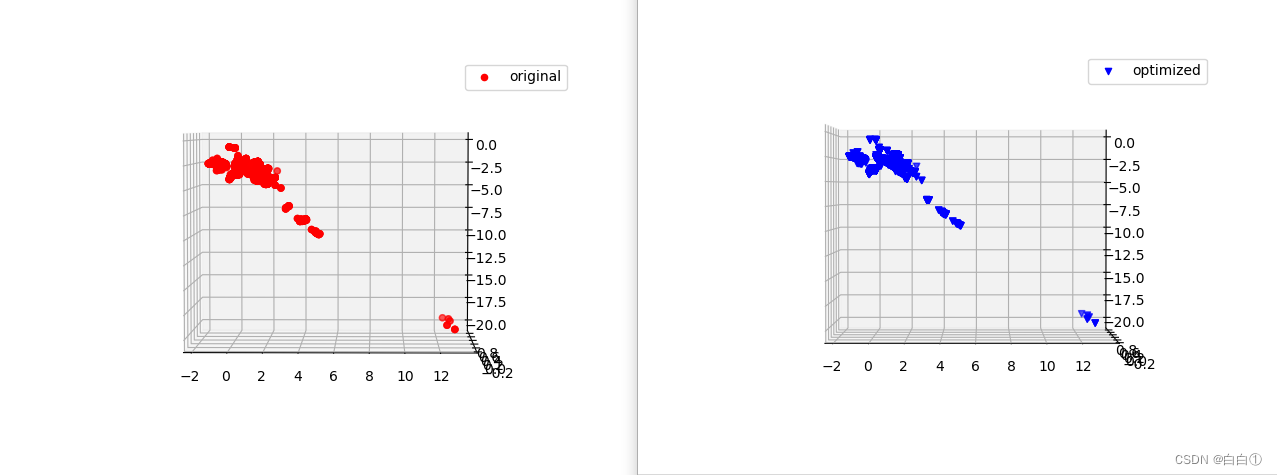前述
ceres在求解视觉导航方面,就依赖一个数学模型,就是相机的投影模型。在视觉导航中,已知的条件只有特征点在图像中的二维坐标
(
u
,
v
)
(u,v)
(u,v),特征点在相机坐标系下的描述应该是一个三维坐标
(
X
,
Y
,
Z
)
(X,Y,Z)
(X,Y,Z),那么从相机坐标系到图像坐标系的变换,涉及到相机的内参矩阵:
(
X
,
Y
,
Z
)
→
(
u
,
v
)
:
Z
[
u
v
1
]
=
[
f
x
0
c
x
0
f
y
c
y
0
0
1
]
[
X
Y
Z
]
(X,Y,Z)\rightarrow(u,v):Z\begin{bmatrix}u\\v\\1\end{bmatrix}=\begin{bmatrix}f_x&0&c_x\\0&f_y&c_y\\0&0&1\end{bmatrix}\begin{bmatrix}X\\Y\\Z\end{bmatrix}
(X,Y,Z)→(u,v):Z
uv1
=
fx000fy0cxcy1
XYZ
在世界坐标系下描述这个特征点是
(
X
W
,
Y
W
,
Z
W
)
(X_W,Y_W,Z_W)
(XW,YW,ZW),世界坐标系到相机坐标系的变换,涉及到相机的外参矩阵:
[
X
Y
Z
]
=
R
[
X
W
Y
W
Z
W
]
+
t
\begin{bmatrix}X\\Y\\Z\end{bmatrix}=R\begin{bmatrix}X_W\\Y_W\\Z_W\end{bmatrix}+t
XYZ
=R
XWYWZW
+t
其中
R
∈
R
3
×
3
R\in R^{3\times 3}
R∈R3×3,
t
∈
R
3
×
1
t\in R^{3\times 1}
t∈R3×1。
那么问题就是,知道了
(
u
,
v
)
(u,v)
(u,v),求解剩下的所有未知量,包括内参矩阵,外参矩阵,特征点在世界坐标系下的描述,一共九个参数,因为一般
f
x
=
f
y
=
f
f_x=f_y=f
fx=fy=f,
c
x
=
c
y
=
c
c_x=c_y=c
cx=cy=c,
R
R
R虽然是
3
×
3
3\times 3
3×3的矩阵,但是实际上可以用Rodrigues角来表示,而Rodrigues角只有三个变量,因此,最终要确认的参数如下:
f
f
f、
c
c
c、
Z
Z
Z、
R
R
R、
t
t
t一共九个参数,用
F
F
F表示上述投影关系,
F
F
F的参数是
(
f
,
c
,
Z
,
R
,
t
)
(f,c,Z,R,t)
(f,c,Z,R,t)
对于视觉导航来说,在某一个时刻,有
m
m
m个路标,其中第
i
i
i个路标被
k
i
k_i
ki个相机观测到,那么就会有相应数量的观测方程,就可以用ceres来求解,很像前面的曲线拟合:有许多组测量值和已知的模型,拟合模型的参数就可以。
实例
实例分析
这里使用bal数据集进行说明,对于BAL数据集来说,关于相机的投影模型是这样的,对于世界坐标系里面某个点
(
X
W
,
Y
W
,
Z
W
)
(X_W,Y_W,Z_W)
(XW,YW,ZW),经过旋转
R
R
R和平移
t
t
t投影到相机坐标系下,经过两个畸变参数和一个焦距参数投影到图像坐标系下,和以往讨论的相机模型不同的是,这里数据集不考虑光心参数,总的来说,可以用以下方程描述:
{
[
X
Y
Z
]
=
R
[
X
W
Y
W
Z
W
]
+
t
[
u
u
n
d
i
s
v
u
n
d
i
s
1
]
=
[
l
×
f
0
0
0
l
×
f
0
0
0
1
]
[
X
/
Z
Y
/
Z
1
]
其中
l
=
1
+
l
1
×
r
2
+
l
2
×
r
4
,
r
2
=
X
2
+
Y
2
Z
2
\begin{cases}\begin{bmatrix}X\\Y\\Z\end{bmatrix}=R\begin{bmatrix}X_W\\Y_W\\Z_W\end{bmatrix}+t\\\begin{bmatrix}u_{undis}\\v_{undis}\\1\end{bmatrix}=\begin{bmatrix}l\times f&0&0\\0&l\times f&0\\0&0&1\end{bmatrix}\begin{bmatrix}X/Z\\Y/Z\\1\end{bmatrix}&其中l=1+l_1\times r^2+l_2\times r^4,r^2=\frac{X^2+Y^2}{Z^2}\end{cases}
⎩
⎨
⎧
XYZ
=R
XWYWZW
+t
uundisvundis1
=
l×f000l×f0001
X/ZY/Z1
其中l=1+l1×r2+l2×r4,r2=Z2X2+Y2
其中相机涉及到九个参数:以罗德里格角表示的旋转(三个),位移参数(三个),畸变参数(两个),焦距参数(一个)
点涉及到的参数有三个:
X
Y
Z
XYZ
XYZ世界坐标
因此,涉及到的ceres的残差方程可以这样写,是关于从世界坐标系重投影到二维图像坐标系的残差的
template<typename T>
bool operator()(const T* const camera,const T* const land_mark,T* residual)const{
T point[3];
ceres::AngleAxisRotatePoint(camera,land_mark,point);
point[0]+=camera[3];
point[1]+=camera[4];
point[2]+=camera[5];
T point_x=-point[0]/point[2];
T point_y=-point[1]/point[2];
const T& l1 = camera[7];
const T& l2 = camera[8];
T r2 = point_x * point_x + point_y * point_y;
T distortion = 1.0 + r2 * (l1 + l2 * r2);
const T& focal = camera[6];
T predicted_x = focal * distortion * point_x;
T predicted_y = focal * distortion * point_y;
// The error is the difference between the predicted and observed position.
residual[0] = predicted_x - observe_x;
residual[1] = predicted_y - observe_y;
return true;
}
实例代码
CMakeLists.txt
cmake_minimum_required(VERSION 2.8)
project(ceres-tutorial)
find_package(Ceres REQUIRED)
find_package(Python3 COMPONENTS Interpreter Development REQUIRED)
include_directories(${CERES_INCLUDE_DIRS})
file(GLOB SOURCE_FILE ${CMAKE_SOURCE_DIR}/*.cpp)
foreach(CPP IN LISTS SOURCE_FILE)
get_filename_component(CPP_FILENAME ${CPP} NAME_WE)
add_executable(${CPP_FILENAME} ${CPP})
target_link_libraries(${CPP_FILENAME} ${CERES_LIBRARIES} Python3::Python Python3::Module)
endforeach(CPP IN LISTS SOURCE_FILE)
C++源码
#include<iostream>
#include<fstream>
#include<vector>
#include<ceres/ceres.h>
#include<ceres/rotation.h>
#include<matplotlibcpp.h>
class bal_data{
public:
bal_data(std::string data_path_):data_path(data_path_){
std::ifstream in_file_obj(data_path);
if(in_file_obj.is_open()){
std::string str1,str2,str3,str4;
in_file_obj>>str1;
in_file_obj>>str2;
in_file_obj>>str3;
camera_cnt=std::stoi(str1);
land_mark_cnt=std::stoi(str2);
observation_cnt=std::stoi(str3);
for(int i=0;i<observation_cnt;i++){
in_file_obj>>str1;
in_file_obj>>str2;
in_file_obj>>str3;
in_file_obj>>str4;
land_mark_observations.push_back(
std::make_pair(
std::make_pair(std::stoi(str1),std::stoi(str2)),
std::make_pair(std::stod(str3),std::stod(str4))
));
}
for(int i=0;i<camera_cnt;i++){
double* temp(new double[9]);
for(int j=0;j<9;j++){
std::string str;
in_file_obj>>str;
temp[j]=std::stod(str);
}
cameras.push_back(temp);
}
for(int i=0;i<land_mark_cnt;i++){
double* temp(new double[3]);
for(int j=0;j<3;j++){
std::string str;
in_file_obj>>str;
temp[j]=std::stod(str);
}
land_marks.push_back(temp);
}
in_file_obj.clear();
}
else{
std::cout<<"load data fails"<<std::endl;
return;
}
}
bal_data():bal_data("../data"){}
void out_data(){
int cnt=0;
for(auto land_mark_observation:land_mark_observations){
std::cout<<cnt++<<" ";
std::cout<<land_mark_observation.first.first<<" "
<<land_mark_observation.first.second<<" "
<<land_mark_observation.second.first<<" "
<<land_mark_observation.second.second<<"\n";
}
}
double* load_camera(int i){
return cameras.at(land_mark_observations.at(i).first.first);
}
double* load_land_mark(int i){
return land_marks.at(land_mark_observations.at(i).first.second);
}
int observation_cnt_(){
return observation_cnt;
}
int land_mark_cnt_(){
return land_mark_cnt;
}
std::pair<double,double> load_observation(int i){
return land_mark_observations.at(i).second;
}
private:
std::string data_path{"../data"};
int camera_cnt{0};
int land_mark_cnt{0};
int observation_cnt{0};
//<<camera_index,land_mark_index>,<observation_x,observation_y>>
std::vector<std::pair<std::pair<int,int>,std::pair<double,double>>> land_mark_observations;
std::vector<double*> cameras;
std::vector<double*> land_marks;
};
struct reproject{
public:
reproject(double x_,double y_):observe_x(x_),observe_y(y_){}
template<typename T>
bool operator()(const T* const camera,const T* const land_mark,T* residual)const{
T point[3];
ceres::AngleAxisRotatePoint(camera,land_mark,point);
point[0]+=camera[3];
point[1]+=camera[4];
point[2]+=camera[5];
T point_x=-point[0]/point[2];
T point_y=-point[1]/point[2];
const T& l1 = camera[7];
const T& l2 = camera[8];
T r2 = point_x * point_x + point_y * point_y;
T distortion = 1.0 + r2 * (l1 + l2 * r2);
const T& focal = camera[6];
T predicted_x = focal * distortion * point_x;
T predicted_y = focal * distortion * point_y;
// The error is the difference between the predicted and observed position.
residual[0] = predicted_x - observe_x;
residual[1] = predicted_y - observe_y;
return true;
}
private:
double observe_x,observe_y;
};
int main(int argc,char**argv){
bal_data object;
// object.out_data();
std::vector<double> x_;
std::vector<double> y_;
std::vector<double> z_;
for(int i=0;i<object.land_mark_cnt_();i++){
x_.push_back(*(object.load_land_mark(i)));
y_.push_back(*(object.load_land_mark(i)+1));
z_.push_back(*(object.load_land_mark(i)+2));
}
ceres::Problem problem;
for(int i=0;i<object.observation_cnt_();i++){
// std::cout<<"point = "<<object.load_observation(i).first<<","<<object.load_observation(i).second<<std::endl;
ceres::CostFunction* cost_function(
new ceres::AutoDiffCostFunction<reproject,2,9,3>(
new reproject(object.load_observation(i).first,object.load_observation(i).second)
)
);
ceres::LossFunction* loss(new ceres::HuberLoss(1.0));
problem.AddResidualBlock(cost_function,nullptr,object.load_camera(i),object.load_land_mark(i));
}
ceres::Solver::Options option;
option.linear_solver_type=ceres::DENSE_SCHUR;
option.minimizer_progress_to_stdout=true;
ceres::Solver::Summary summary;
ceres::Solve(option,&problem,&summary);
std::cout<<summary.FullReport()<<std::endl;
std::vector<double> x;
std::vector<double> y;
std::vector<double> z;
for(int i=0;i<object.land_mark_cnt_();i++){
x.push_back(*(object.load_land_mark(i)));
y.push_back(*(object.load_land_mark(i)+1));
z.push_back(*(object.load_land_mark(i)+2));
}
std::map<std::string,std::string> kw;
kw["marker"]="v";
kw["color"]="blue";
kw["label"]="optimized";
matplotlibcpp::scatter(x,y,z,1.,kw);
matplotlibcpp::legend();
kw["marker"]="o";
kw["color"]="red";
kw["label"]="original";
matplotlibcpp::scatter(x,y,z,1.,kw);
matplotlibcpp::legend();
matplotlibcpp::show();
return 0;
}
使用
在源码文件夹中新建build文件夹编译,把从BAL官网下载数据集,数据集文件放在和build文件夹同级文件夹里面,执行以下
./simple_bal ../data
实例结果
这里输出的结果是对于某一个固定时刻内,由五十台相机确定的一组路标点的坐标
 似乎看不出来差别,哈哈。
似乎看不出来差别,哈哈。






















 716
716











 被折叠的 条评论
为什么被折叠?
被折叠的 条评论
为什么被折叠?








